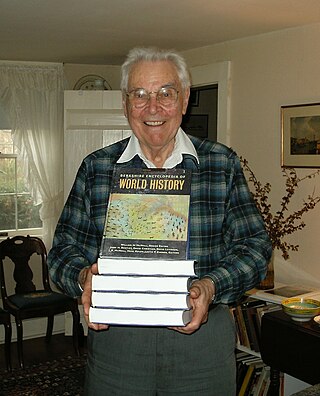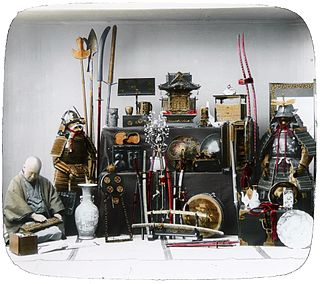
Abd ar-Rahman II (792–852) was the fourth Umayyad Emir of Córdoba in al-Andalus from 822 until his death. A vigorous and effective frontier warrior, he was also well known as a patron of the arts.

A catapult is a ballistic device used to launch a projectile a great distance without the aid of gunpowder or other propellants – particularly various types of ancient and medieval siege engines. A catapult uses the sudden release of stored potential energy to propel its payload. Most convert tension or torsion energy that was more slowly and manually built up within the device before release, via springs, bows, twisted rope, elastic, or any of numerous other materials and mechanisms.

Gunpowder, also commonly known as black powder to distinguish it from modern smokeless powder, is the earliest known chemical explosive. It consists of a mixture of sulfur, carbon, and potassium nitrate (saltpeter). The sulfur and carbon act as fuels while the saltpeter is an oxidizer. Gunpowder has been widely used as a propellant in firearms, artillery, rocketry, and pyrotechnics, including use as a blasting agent for explosives in quarrying, mining, building pipelines, tunnels, and roads.

The ballista, plural ballistae, sometimes called bolt thrower, was an ancient missile weapon that launched either bolts or stones at a distant target.

Military technology is the application of technology for use in warfare. It comprises the kinds of technology that are distinctly military in nature and not civilian in application, usually because they lack useful or legal civilian applications, or are dangerous to use without appropriate military training.

Ballistics is the field of mechanics concerned with the launching, flight behaviour and impact effects of projectiles, especially ranged weapon munitions such as bullets, unguided bombs, rockets or the like; the science or art of designing and accelerating projectiles so as to achieve a desired performance.

The urogenital sinus is a part of the human body only present in the development of the urinary and reproductive organs. It is the ventral part of the cloaca, formed after the cloaca separates from the anal canal during the fourth to seventh weeks of development.

The Messerschmitt Me 328 was a prototype pulsejet-powered fighter aircraft designed and produced by the German aircraft manufacturer Messerschmitt AG.

A ranged weapon is any weapon that can engage targets beyond hand-to-hand distance, i.e. at distances greater than the physical reach of the user holding the weapon itself. The act of using such a weapon is also known as shooting. It is sometimes also called projectile weapon or missile weapon because it typically works by launching solid projectiles ("missiles"), though technically a fluid-projector and a directed-energy weapon are also ranged weapons. In contrast, a weapon intended to be used in hand-to-hand combat is called a melee weapon.

Anvil firing is the practice of firing an anvil into the air with gunpowder.
Absinthiana is the paraphernalia surrounding the consumption of absinthe. Due to the bitter taste and high alcohol content of this drink, a need for dilution with water had led drinkers to a drinking ritual. Originally, absinthe was served in standard stemmed wine or water glasses and water was added from a simple carafe. But as its popularity grew so did the variety of implements used, such as specialty glasses and complex brouilleurs. In the period since absinthe was made illegal in the US, antique dealers have seen dramatic increases in the prices of these artifacts there. Some absinthe spoons can fetch thousands of dollars. Many 19th century companies used the elaborate barware to advertise their brands. Today, many contemporary distilleries are also producing decorative branded barware for the same purpose.

William Hardy McNeill was an American historian and author, noted for his argument that contact and exchange among civilizations is what drives human history forward, first postulated in The Rise of the West (1963). He was the Robert A. Millikan Distinguished Service Professor Emeritus of History at the University of Chicago, where he taught from 1947 until his retirement in 1987.

A potato cannon is a pipe-based cannon that uses air pressure (pneumatic), or combustion of a flammable gas, to launch projectiles at high speeds. They are built to fire chunks of potato, as a hobby, or to fire other sorts of projectiles, for practical use. Projectiles or failing guns can be dangerous and result in life-threatening injuries, including cranial fractures, enucleation, and blindness if a person is hit.

Major innovations in the history of weapons have included the adoption of different materials – from stone and wood to different metals, and modern synthetic materials such as plastics – and the developments of different weapon styles either to fit the terrain or to support or counteract different battlefield tactics and defensive equipment.
Gunpowder weapons in the Song dynasty included fire arrows, gunpowder lit flamethrowers, soft shell bombs, hard shell iron bombs, fire lances, and possibly early cannons known as "eruptors". The eruptors, such as the "multiple bullets magazine eruptors", consisting of a tube of bronze or cast iron that was filled with about 100 lead balls, and the "flying-cloud thunderclap eruptor", were early cast-iron proto-cannons that did not include single shots that occluded the barrel. The use of proto-cannon, and other gunpowder weapons, enabled the Song dynasty to ward off its generally militarily superior enemies—the Khitan led Liao, Tangut led Western Xia, and Jurchen led Jin—until its final collapse under the onslaught of the Mongol forces of Kublai Khan and his Yuan dynasty in the late 13th century.
Backyard Ballistics is a how-to book by William Gurstelle that was published in 2001. It is full of experiments that can be done relatively inexpensively and can be easily executed. It also includes the history and mechanical principles of some of the inventions and projects. From catapults to rockets, this book describes accessible ways to create these at home or in the classroom. In addition to recreational use by individuals, teacher's guides have been developed and science fair projects designed around this book. It has been cited in several educational and scientific journals.

Electrum or Electrum (for Len Lye) (Len Lye being a New Zealand artist), is a 1998 sculpture by Eric Orr and Greg Leyh built around the world's largest Tesla coil. The coil stands 11.5 meters (37 feet) in height, operates at power levels up to 130,000 watts, and produces 3 million volts on its spherical top terminal. The sculpture is currently installed in a private area at Gibbs Farm in Kaukapakapa in New Zealand, a sculpture park art collection of businessman Alan Gibbs. The top, spherical electrode of the sculpture is large enough to hold a human. The piece was the subject of a 2000 documentary, "Electrum: Science as Art" and the 2011 documentary Lightning Dreams, by Alberta Chu.

Forensic firearm examination is the forensic process of examining the characteristics of firearms or bullets left behind at a crime scene. Specialists in this field try to link bullets to weapons and weapons to individuals. They can raise and record obliterated serial numbers in an attempt to find the registered owner of a weapon and look for fingerprints on a weapon and cartridges.
The Royal Vietnamese army was the primary military body of the Vietnamese states of Jinghai and Đại Việt and the armed forces of the Vietnamese monarchy from 938 to 1789. It was disbanded and succeeded by the Imperial Vietnamese army of the Nguyễn dynasty in early 19th century.















